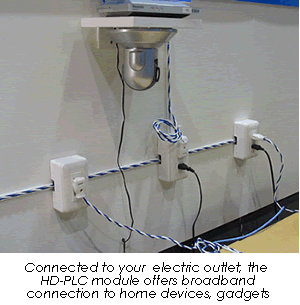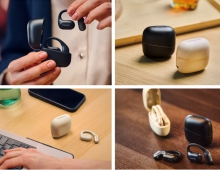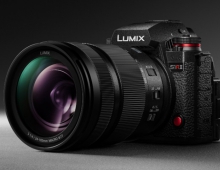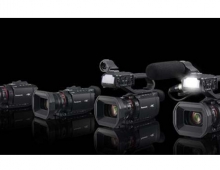
Panasonic Helps Electric Outlet Go Broadband
Panasonic's High Definition Power Line Communication (HD-PLC) module allows the common electric socket to serve as a home connection to broadband. The Japanese giant has come up with technology that uses electric wiring in the home to relay not just electricity but also data.
The technology could be an alernative to common Ethernet cable or the wireless network connections.
The HD-PLC evaluation module allows high-speed transmission of high-definition video, audio, data and voice over a home's pre-existing indoor wiring for an easily installed and secure home networking solution.
 The technology has been around for some time - including in the United States - but
Panasonic's system is unique in that it delivers fast-speed broadband information at up to
170 megabits per second, which is faster than Ethernet.
The technology has been around for some time - including in the United States - but
Panasonic's system is unique in that it delivers fast-speed broadband information at up to
170 megabits per second, which is faster than Ethernet.
The module contains a complete HD-PLC LSI engine for managing high-speed transmission of information, data conversion from an Ethernet connection, secure information distribution over a network, data error correction, and interference reduction, a common concern for power line communications technology. It also includes Quality of Service functionality that provides dedicated bandwidth, jitter control and latency management as is required for real-time applications such as video and telephony applications. In addition, the module features the 128bit AES encryption technology, providing enhanced security.
The advantage of this technology is that electric socket is everywhere inside a house. Right now, a broadband outlet still isn't usually available in every room, even in homes that have broadband connections. In the future home envisioned by Panasonic, people will be able to download and watch high-definition movies in any room of the house that has an outlet.
According to Panasonic, after attaching a a special device into a socket, people will be be able to plug a TV or other gadgets into a socket for instant connection to broadband.
Panasonic plans to sell refrigerators, TVs and other products with the chip already installed. For axample, a network-connected refrigerator may allow users to connect from a mobile phone or laptop to check whether you're low on milk.
But for now, an adaptor when plugged into an outlet will allow gadgets with Ethernet connections - even those without the Matsushita chip - to receive broadband.
"Panasonic's goal is to provide a complete easy to use home networking solution for its customers," said Paul Liao, chief technology officer of Panasonic Corporation of North America. "With the commitment of our OEM partners to develop a complete range of interoperable and highly capable devices on the HD-PLC standard, Panasonic is confident that businesses and consumers everywhere will soon enjoy the benefit of affordable, accessible, and secure networking and information systems."
Samples of the technology are being made available to companies, including other Japanese electronics makers, that may wish to use it for their products, Matsushita officials said. A demonstration of the technology will be on show at the CEATEC exhibition that showcases electronic technology, opening October 4 to 8 near Tokyo.
Acceptance of the technology is more likely in Europe and the United States because of stricter regulations over power line use in Japan, according to Panasonic. The company is in talks with the Japanese government to have regulations eased.
The HD-PLC evaluation module allows high-speed transmission of high-definition video, audio, data and voice over a home's pre-existing indoor wiring for an easily installed and secure home networking solution.
 The technology has been around for some time - including in the United States - but
Panasonic's system is unique in that it delivers fast-speed broadband information at up to
170 megabits per second, which is faster than Ethernet.
The technology has been around for some time - including in the United States - but
Panasonic's system is unique in that it delivers fast-speed broadband information at up to
170 megabits per second, which is faster than Ethernet.
The module contains a complete HD-PLC LSI engine for managing high-speed transmission of information, data conversion from an Ethernet connection, secure information distribution over a network, data error correction, and interference reduction, a common concern for power line communications technology. It also includes Quality of Service functionality that provides dedicated bandwidth, jitter control and latency management as is required for real-time applications such as video and telephony applications. In addition, the module features the 128bit AES encryption technology, providing enhanced security.
The advantage of this technology is that electric socket is everywhere inside a house. Right now, a broadband outlet still isn't usually available in every room, even in homes that have broadband connections. In the future home envisioned by Panasonic, people will be able to download and watch high-definition movies in any room of the house that has an outlet.
According to Panasonic, after attaching a a special device into a socket, people will be be able to plug a TV or other gadgets into a socket for instant connection to broadband.
Panasonic plans to sell refrigerators, TVs and other products with the chip already installed. For axample, a network-connected refrigerator may allow users to connect from a mobile phone or laptop to check whether you're low on milk.
But for now, an adaptor when plugged into an outlet will allow gadgets with Ethernet connections - even those without the Matsushita chip - to receive broadband.
"Panasonic's goal is to provide a complete easy to use home networking solution for its customers," said Paul Liao, chief technology officer of Panasonic Corporation of North America. "With the commitment of our OEM partners to develop a complete range of interoperable and highly capable devices on the HD-PLC standard, Panasonic is confident that businesses and consumers everywhere will soon enjoy the benefit of affordable, accessible, and secure networking and information systems."
Samples of the technology are being made available to companies, including other Japanese electronics makers, that may wish to use it for their products, Matsushita officials said. A demonstration of the technology will be on show at the CEATEC exhibition that showcases electronic technology, opening October 4 to 8 near Tokyo.
Acceptance of the technology is more likely in Europe and the United States because of stricter regulations over power line use in Japan, according to Panasonic. The company is in talks with the Japanese government to have regulations eased.





















